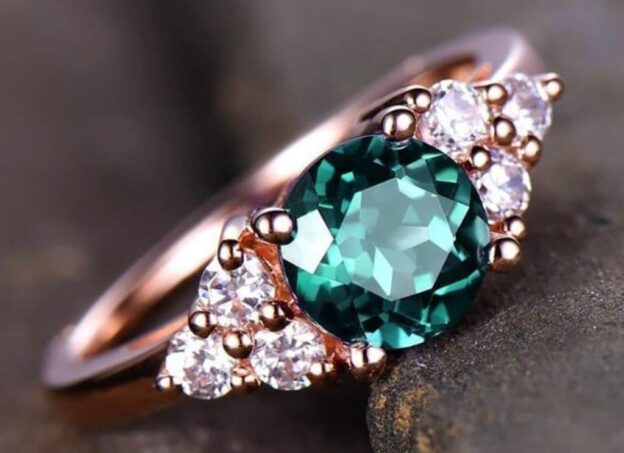- Chemical formula – Al2BeO4, impurity – Cr.
- Color – bluish green, sometimes olive, yellow, rarely colorless.
- The system is rhombic.
- Hardness – 8.5 on the Mohs scale.
- Density – 3.5-3.8 g per cm3.
- The fracture is conchial.
Varieties of alexandrite
Translucent alexandrites are characterized by the effect of opalescence – “cat’s eye”. Such crystals are called cymophanes. Green and red highlights on the edges of the stone are reflected in one direction when light enters, which leads to the appearance of a bright strip on its surface. The ability to change color distinguishes alexandrite from other stones and makes it unique in the jewelry market.
They say about alexandrite: “In the morning he is an emerald, in the evening he is a ruby.” In the old days, it was called a stone, for which “the morning is green, and the evening is red,” because in the light of the sun it plays with all shades of green, and under an electric lamp its color turns red.
Alexandrite deposits
All the deposits being developed today are placer deposits. The main suppliers of alexandrite to the world market are Sri Lanka, Brazil, Zimbabwe, Kenya. In addition, deposits are known in Burma, Madagascar and Tasmania, in the United States.
Real alexandrite comes from the Urals!
The world’s only primary alexandrite deposit is located in the Urals. Unfortunately, over the course of several decades, it was fully developed. Ural alexandrites were considered the best and at one time were the standards of quality. Only Ural alexandrite in daylight has a color very similar to the color of emerald. But at the same time, the Ural stones are inferior in size, purity and transparency to stones from the placers of Brazil and Sri Lanka.
If the Ural alexandrite without inclusions is very rare, then for alexandrite from Brazil, Sri Lanka, Africa it is rather the norm.
Processing and use of alexandrite
The most common forms of alexandrite cut are stepped and drop-shaped. Cymophanes are usually cabochonized in order to fully convey the play of light inside the stone. In jewelry, alexandrite is often combined with emeralds, diamonds and pearls.
Alexandrite: impudent fakes, high-quality imitations and familiar synthetics
The main signs
The only stone that can be confused externally with alexandrite is green andalusite. However, such a substitution does not make sense, because andalusite is not found more often in nature. Artificial corundum and spinel are used as alexandrite imitators. If a natural gem shimmers with green-red colors, then synthetic analogs change color from blue-gray to pink.
In addition, the reverse effect of natural alexandrite is much less pronounced. However, it is quite difficult for a layman to distinguish a fake. Professional appraisers use special devices – a refractometer and a spectroscope to determine the origin of a mineral. The refractive index of natural alexandrite is 1.74, and at the red end of the color spectrum, the stone exhibits dark absorption lines.
Imitation and synthetics
Alexandrite is a rare guest in the jewelry market, and it is not so easy to buy jewelry with it, even if you are not a poor person. It is much easier to buy synthesized alexandrite – these are corundum or spinel grown in laboratory conditions, which, just like natural stone, change color under natural and artificial light, and outwardly do not differ from it in any way. Such alexandrites are quite affordable for middle-income buyers.
Particularly widespread inserts of color-changing synthetic corundum were used in the USSR. At the same time, buyers, as a rule, believed that they were buying a piece of jewelry with real alexandrite. Only specialists can distinguish a natural stone from synthetic corundum or spinel using a refractometer. The production of synthetic alexandrite began in 1973.
The world’s best synthetic alexandrite is industrially produced in Russia, in Novosibirsk. These stones are much purer than natural ones and have a red-violet color, close to amethyst, in artificial light and blue-violet in daylight. They are hundreds of times cheaper than natural alexandrites. The synthesis volume is only a few kilograms per year. By the way, synthetic alexandrites from Russia are actively sold on the US market under the guise of natural stones from Brazil, Sri Lanka and Africa. Many dealers are not even aware of the fraud.

